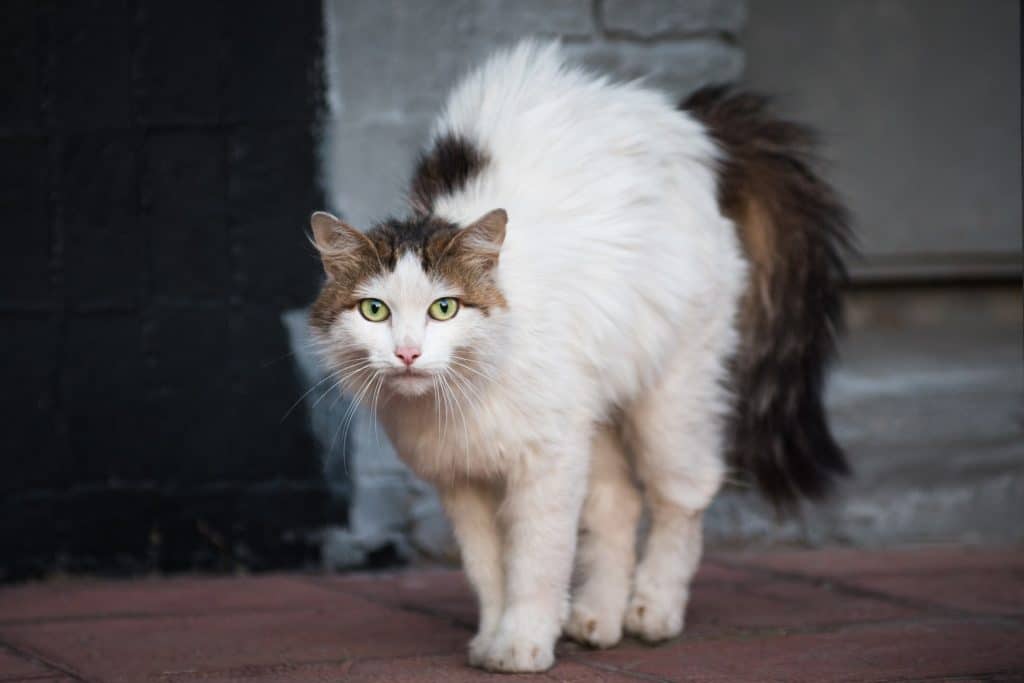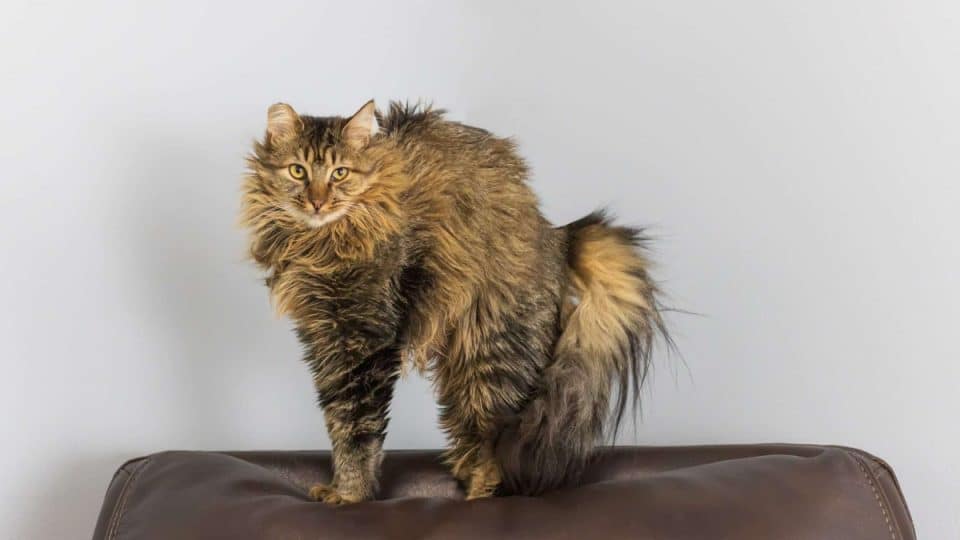It’s one of a cat’s most iconic poses: an arched back, fur on end, and tail straight up. If your cat’s arching their back, it can mean many different things. For example, an arched back could signify stretching, playfulness, pain, defensiveness, or a desire for petting, Molly DeVoss, certified feline training and behaviour specialist (CFTBS) and owner of Cat Behavior Solutions in the USA, explains.
In kittenhood, cats are more likely to poof and pounce in an arched position because they’re playing. However, as cats reach adulthood, an arched back and raised hair—called piloerection—are more commonly associated with defensive behaviours. Either way, an arched back with piloerection makes a cat appear larger and more intimidating. Whatever the reason your cat’s arching their back, feel reassured that it’s common and there are ways to fix it.
Below, we’ll explore how to use context clues and body language to decipher the meaning behind a cat’s arched back.
1. Your Cat Is Stretching
Cats have a lot of vertebrae for their small stature, which makes them incredibly flexible. For example, cats arch their backs after a long nap to remain lumbar, stretching from their paws to their spine.
“If your cat typically enjoys pets down the back, there’s no reason why they wouldn’t appreciate it while stretching,” DeVoss says. However, some cats may have extreme sensitivity along their spine. Petting can cause skin rippling, nipping, or reactive licking in cats. If a cat reacts this way, they may not enjoy the sensation, and petting should stop if they’re overstimulated.

iStock/wickedberlin
2. Your Cat Is Acting Aggressive
According to DeVoss, cats have evolved as a solitary species, so their nature is to respond defensively or aggressively to cats they don’t recognise. For example, to appear larger and more intimidating, cats raise their fur, arch their backs, and walk sideways with their eyes locked on the perceived threat. In addition, they may hiss, growl, or snarl with exposed teeth.
If the aggressive pose is directed at you, slowly back away and give the cat space. Once you’ve created distance, try talking sweetly or slowly blinking at them. If the aggression is directed towards another cat, shake a treat bag to diffuse the situation. As a last resort, DeVoss uses cardboard to interrupt eye contact between the cats. However, never pick up an aggressive cat or physically place yourself between them.
Sadly, 27% of cats are surrendered to shelters for behavioural reasons related to aggression. Cat aggression can be avoided with early socialisation, positive reinforcement rather than punishment, an enriching environment, and slowly introducing new pets.
3. Your Cat Is Grooming
Grooming hard-to-reach places like the base of the tail can take a fair amount of contortion. But, thanks to cats’ plethora of vertebrae, they can reach those spots with an arch of their backs. Whether or not a cat wants you to pet them while grooming depends on your relationship with the cat and their personal petting preferences.
4. Your Cat Is Afraid
Frightened kittens or cats may assume the ‘Halloween cat’ pose with their backs arched and hairs on end. Kittens will likely run away when frightened, but adult cats may become aggressive. They’ll lock their eyes with their preserved threat and move sideways, their backs still arched.
When fear is directed towards you, there are ways to build trust with a cat, such as daily feeding and interactions or positive reinforcement and play. Creating secure bonds with timid cats takes patience and time, but the payoffs are immeasurable.

iStock/Ekaterina Gorokhova
5. Your Cat Is Playing
Cats start arching their back in kittenhood. “When kittens’ poof’ and pounce, it is usually mock play simulating the hunting sequence,” DeVoss explains. That kitten-like behaviour can carry into adulthood when a cat gets a sudden burst of energy. You’ll know a cat with an arched back is feeling playful rather than fearful or aggressive if they pounce towards you and not away, DeVoss says.
6. Your Cat Is Enjoying Pets
When cats arch their backs while being petted, it’s a sign they enjoy the sensation. “They are trying to push into your hand,” DeVoss explains. Other signs cats love being petted include purring and headbutting. However, cats can get overstimulated by pets. So, take a break between each stroke to avoid petting aggression, which could lead to biting or swatting.
7. Your Cat Is Showing You They’re In Pain
Cats can display pain in many ways, and they’re not all obvious. “Cats arch their backs while lying down to get a stretch,” DeVoss says. “However, when a cat has an arched or hunched back that doesn’t go back to normal posture, it can indicate pain.” Other signs your cat may be in pain include the following:
- hiding
- decrease in appetite
- mobility issues or limping, including a reluctance to move or raise their head
- nipping in response to touch
- decrease or increase in vocalisation
- change in grooming habits
8. Your Cat Is Communicating With You
Cats use body language to communicate with humans and other animals. For example, when a cat arches their back, it can signal that they want attention or want to play. This is often accompanied by purring, meowing, or rubbing against your legs. In other situations, cats arch their back as a defensive posture when feeling threatened or uncomfortable. By observing your cat’s body language accompanying arching, you can better understand what they’re saying and respond accordingly.

iStock/Nils Jacobi
Pay Attention To Your Cat’s Arched Back
If a cat arches their back, they could be stretching, playing, in pain, or defensive. Again, the context of the situation and other body language signals can help determine what your cat is trying to communicate.
For instance, an arched back with piloerection means the cat is trying to appear larger and more intimidating, which could be playful or aggressive. To understand which one it is, look for other clues, including if they’re moving away or toward you and if they’re purring or snarling.
Additionally, cats that are afraid or in pain may display an arched back, whereas an arched back while being petted typically indicates that the cat enjoys attention. Understanding cat body language is the first step in building stronger bonds with our feline friends.



